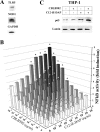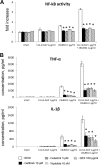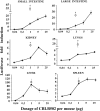Combined stimulation of Toll-like receptor 5 and NOD1 strongly potentiates activity of NF-κB, resulting in enhanced innate immune reactions and resistance to Salmonella enterica serovar Typhimurium infection
- PMID: 23897616
- PMCID: PMC3811746
- DOI: 10.1128/IAI.00525-13
Combined stimulation of Toll-like receptor 5 and NOD1 strongly potentiates activity of NF-κB, resulting in enhanced innate immune reactions and resistance to Salmonella enterica serovar Typhimurium infection
Abstract
Pathogen recognition receptors (PRRs) are essential components of host innate immune systems that detect specific conserved pathogen-associated molecular patterns (PAMPs) presented by microorganisms. Members of two families of PRRs, transmembrane Toll-like receptors (TLRs 1, 2, 4, 5, and 6) and cytosolic NOD receptors (NOD1 and NOD2), are stimulated upon recognition of various bacterial PAMPs. Such stimulation leads to induction of a number of immune defense reactions, mainly triggered via activation of the transcription factor NF-κB. While coordination of responses initiated via different PRRs sensing multiple PAMPS present during an infection makes clear biological sense for the host, such interactions have not been fully characterized. Here, we demonstrate that combined stimulation of NOD1 and TLR5 (as well as other NOD and TLR family members) strongly potentiates activity of NF-κB and induces enhanced levels of innate immune reactions (e.g., cytokine production) both in vitro and in vivo. Moreover, we show that an increased level of NF-κB activity plays a critical role in formation of downstream responses. In live mice, synergy between these receptors resulting in potentiation of NF-κB activity was organ specific, being most prominent in the gastrointestinal tract. Coordinated activity of NOD1 and TLR5 significantly increased protection of mice against enteroinvasive Salmonella infection. Obtained results suggest that cooperation of NOD and TLR receptors is important for effective responses to microbial infection in vivo.
Figures








Comment in
-
Arginine cools the inflamed gut.Infect Immun. 2013 Oct;81(10):3500-2. doi: 10.1128/IAI.00789-13. Epub 2013 Jul 29. Infect Immun. 2013. PMID: 23897606 Free PMC article. No abstract available.
Similar articles
-
Role of mouse peptidoglycan recognition protein PGLYRP2 in the innate immune response to Salmonella enterica serovar Typhimurium infection in vivo.Infect Immun. 2012 Aug;80(8):2645-54. doi: 10.1128/IAI.00168-12. Epub 2012 May 21. Infect Immun. 2012. PMID: 22615249 Free PMC article.
-
Nod1 is an essential signal transducer in intestinal epithelial cells infected with bacteria that avoid recognition by toll-like receptors.Infect Immun. 2004 Mar;72(3):1487-95. doi: 10.1128/IAI.72.3.1487-1495.2004. Infect Immun. 2004. PMID: 14977954 Free PMC article.
-
NOD1 and NOD2 stimulation triggers innate immune responses of human periodontal ligament cells.Int J Mol Med. 2012 Apr;29(4):699-703. doi: 10.3892/ijmm.2012.878. Epub 2012 Jan 3. Int J Mol Med. 2012. PMID: 22218461 Free PMC article.
-
The role of NOD1 and NOD2 in host defense against chlamydial infection.FEMS Microbiol Lett. 2016 Sep;363(17):fnw170. doi: 10.1093/femsle/fnw170. Epub 2016 Jul 14. FEMS Microbiol Lett. 2016. PMID: 27421958 Review.
-
NOD1 and NOD2 Are Potential Therapeutic Targets for Cancer Immunotherapy.Comput Intell Neurosci. 2022 Oct 10;2022:2271788. doi: 10.1155/2022/2271788. eCollection 2022. Comput Intell Neurosci. 2022. Retraction in: Comput Intell Neurosci. 2023 Aug 9;2023:9847813. doi: 10.1155/2023/9847813. PMID: 36262606 Free PMC article. Retracted. Review.
Cited by
-
Novel Immunomodulatory Flagellin-Like Protein FlaC in Campylobacter jejuni and Other Campylobacterales.mSphere. 2015 Dec 2;1(1):e00028-15. doi: 10.1128/mSphere.00028-15. eCollection 2016 Jan-Feb. mSphere. 2015. PMID: 27303676 Free PMC article.
-
Extracellular matrix-related genes play an important role in the progression of NMIBC to MIBC: a bioinformatics analysis study.Biosci Rep. 2020 May 29;40(5):BSR20194192. doi: 10.1042/BSR20194192. Biosci Rep. 2020. PMID: 32391563 Free PMC article.
-
Nucleotide-Oligomerizing Domain-1 Activation Exaggerates Cigarette Smoke-Induced Chronic Obstructive Pulmonary-Like Disease in Mice.Int J Chron Obstruct Pulmon Dis. 2021 Sep 16;16:2605-2615. doi: 10.2147/COPD.S323616. eCollection 2021. Int J Chron Obstruct Pulmon Dis. 2021. PMID: 34556981 Free PMC article.
-
Powerful Complex Immunoadjuvant Based on Synergistic Effect of Combined TLR4 and NOD2 Activation Significantly Enhances Magnitude of Humoral and Cellular Adaptive Immune Responses.PLoS One. 2016 May 17;11(5):e0155650. doi: 10.1371/journal.pone.0155650. eCollection 2016. PLoS One. 2016. PMID: 27187797 Free PMC article.
-
Synergistic Activation of Toll-Like and NOD Receptors by Complementary Antigens as Facilitators of Autoimmune Disease: Review, Model and Novel Predictions.Int J Mol Sci. 2020 Jun 30;21(13):4645. doi: 10.3390/ijms21134645. Int J Mol Sci. 2020. PMID: 32629865 Free PMC article. Review.
References
-
- Reiling N, Hölscher C, Fehrenbach A, Kröger S, Kirschning CJ, Goyert S, Ehlers S. 2002. Cutting edge: Toll-like receptor (TLR)2- and TLR4-mediated pathogen recognition in resistance to airborne infection with Mycobacterium tuberculosis. J. Immunol. 169:3480–3484 - PubMed
-
- Takeuchi O, Hoshino K, Akira S. 2000. Cutting edge: TLR2-deficient and MyD88-deficient mice are highly susceptible to Staphylococcus aureus infection. J. Immunol. 165:5392–5396 - PubMed
-
- Silva GK, Gutierrez FR, Guedes PM, Horta CV, Cunha LD, Mineo TW, Santiago-Silva J, Kobayashi KS, Flavell RA, Silva JS, Zamboni DS. 2010. Cutting edge: nucleotide-binding oligomerization domain 1-dependent responses account for murine resistance against Trypanosoma cruzi infection. J. Immunol. 184:1148–1152 - PubMed
-
- Kobayashi KS, Chamaillard M, Ogura Y, Henegariu O, Inohara N, Nuñez G, Flavell RA. 2005. Nod2-dependent regulation of innate and adaptive immunity in the intestinal tract. Science 307:731–734 - PubMed
Publication types
MeSH terms
Substances
Grants and funding
LinkOut - more resources
Full Text Sources
Other Literature Sources

